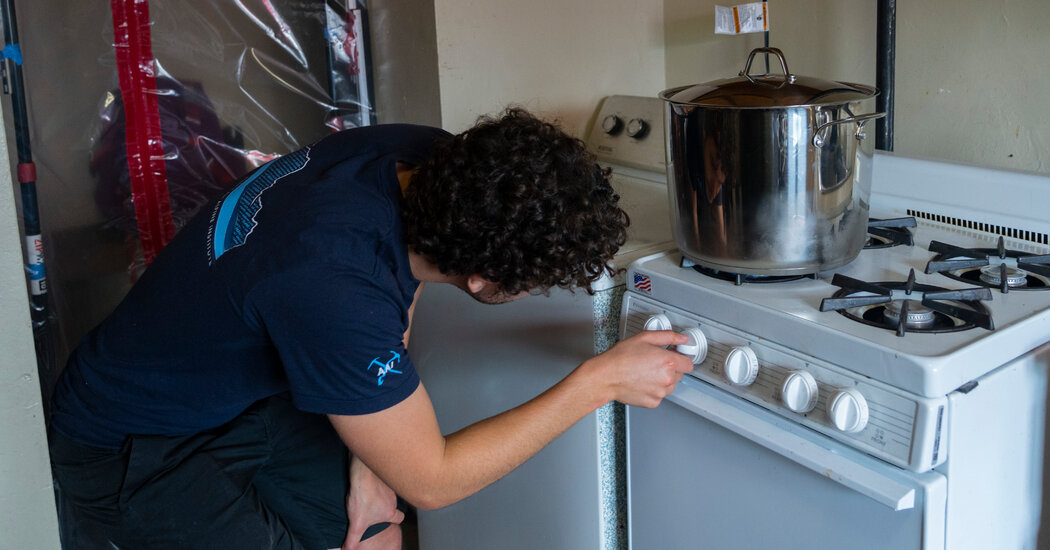By Hiroko Tabuchi June 17, 2023
Using a single gas-stove burner can raise indoor concentrations of benzene, which is linked to cancer risk, to above what’s found in secondhand tobacco smoke and even to levels that have prompted local investigations when detected outdoors, according to a new study.
For the peer-reviewed study, researchers at Stanford’s Doerr School of Sustainability measured benzene emissions from stoves at 87 homes in California and Colorado and found that natural gas and propane stoves emitted benzene that frequently reached indoor concentrations above health benchmarks set by the World Health Organization and other public agencies.
In about a third of the homes, a single gas burner on high or an oven set to 350 degrees Fahrenheit for 45 minutes raised benzene levels above the upper range of indoor concentrations seen in secondhand tobacco smoke, the researchers found. They noted that similar concentrations, when identified in 2020 near schools in Greater Los Angeles and the Colorado Front Range, led to investigations by the authorities there.
“I found it startling,” said Yannai Kashtan, the lead author of the study, “that concentrations that were enough to trigger a public outcry when they were detected outside are concentrations that we’ve found repeatedly inside, just from stoves in people’s homes.”
A mounting body of research has documented significant indoor air pollution and negative health effects from gas stoves. Gas stoves emit other harmful pollutants like nitrogen dioxide, carbon monoxide and formaldehyde and can also leak methane, a potent greenhouse gas, even when they are turned off. A study published in December estimated that 12.7 percent of childhood asthma in the United States was linked to gas-burning stoves.
But the latest study, published this week in the journal Environmental Science and Technology, was the first to focus on quantifying the benzene that comes off a stove’s flame in the process of combustion.
The United Nation’s International Agency for Research on Cancer and the U.S. Environmental Protection Agency define benzene as a human carcinogen. Breathing in the chemical can increase the risk of leukemia and lymphoma among other serious health effects. Doctors say no level of exposure is safe.
The Stanford team measured emissions from the food itself, frying up some fish, as well as bacon, and found negligible benzene emissions. Emissions in the home from electric and induction stoves are also negligible, the Stanford research and other studies have found.
Background: Stoves have become a ‘culture war’ issue. Concerns over the health effects of gas stoves have already prompted some cities and states to seek to phase out gas connections in residential buildings. The federal government is moving to strengthen efficiency standards for gas stoves.
Still, the issue has become politicized. On Wednesday, House Republicans pushed through a bill that would prevent federal funds from being used to regulate gas stoves as a hazardous product. The measure wasn’t expected to pass the Senate, but underscored the divisiveness of the issue among the nation’s politicians, despite the science.
Mr. Kashtan, a Ph.D. candidate who is the lead Stanford researcher, noted that the study focused on single-family houses in California and Colorado, which tend to be larger than apartments in big cities such as New York. More recent testing by the Stanford team detected higher concentrations of some pollutants from gas stoves in tiny New York kitchens and found that those pollutants quickly traveled throughout the home and lingered, sometimes for hours.
Dr. Janice L. Kirsch, an oncologist and former investigator on a large-scale study of childhood leukemia who was not involved in the Stanford research, said the levels of benzene the researchers found coming off gas stoves in peoples’ homes were alarming.
“We knew that when you burn methane, you get benzene. But to actually do the measurements is groundbreaking, and levels are higher than what was expected. It’s way more dangerous,” Dr. Kirsch said. “Benzene is the stuff nightmares are made of.”
What concerned her particularly was that mounting research showed how people were being exposed to harmful chemicals both outside their homes, from things like traffic, factories or wildfire smoke, and indoors.
But inside, at least, people have somewhat more control over their exposure. “That gives us a way forward,” Dr. Kirsch said. People could buy relatively inexpensive induction hot plates, she said, or use toaster ovens and electric kettles when possible. “And ventilate,” she said. “You have to ventilate.”



as a fairly partial party (I like gas stovetops, don’t own one):
statistically significant doesn’t necessarily measure how important the effect is (or translatable to real life scenarios)
one study found people exposed to ~50 mg/m^3 benzene for 4 months to 16 years developed cancer (with some studies reporting ~20 mg/m^3, and a minimum of 2 mg/m^3 over 6 years)
this study reports ~3-6 ug/m^3, which is at a minimum 3 orders of magnitude less than the what was previously reported to cause cancer. (and also uses this 3 ug/m^3 based on some california recommendation)
TL;DR does it emit benzene? yes.
does it emit enough to cause cancer? untested. extrapolated answer: probably not.
Thank you for saying what I was unable to get out in less than 5000 characters - this summarizes what I was assuming to be true but didn’t actually check the numbers on.
I guess I just choose based on my conscience. I’ve made a lot of life changes in the past that either took away “pleasures” or added a bit more effort to my daily life in order to live a more harmonious life.
Choosing an electric stove cost me neither quality of life or significant cost to the bank. We are moving towards a totally petroleum product free home within 10 years (ya plastic exists)